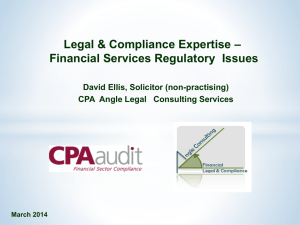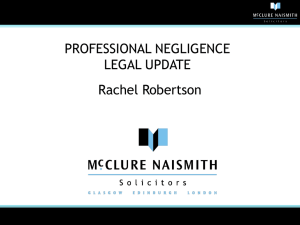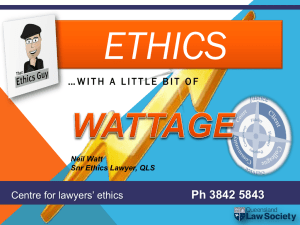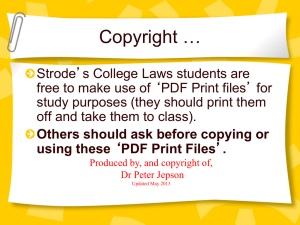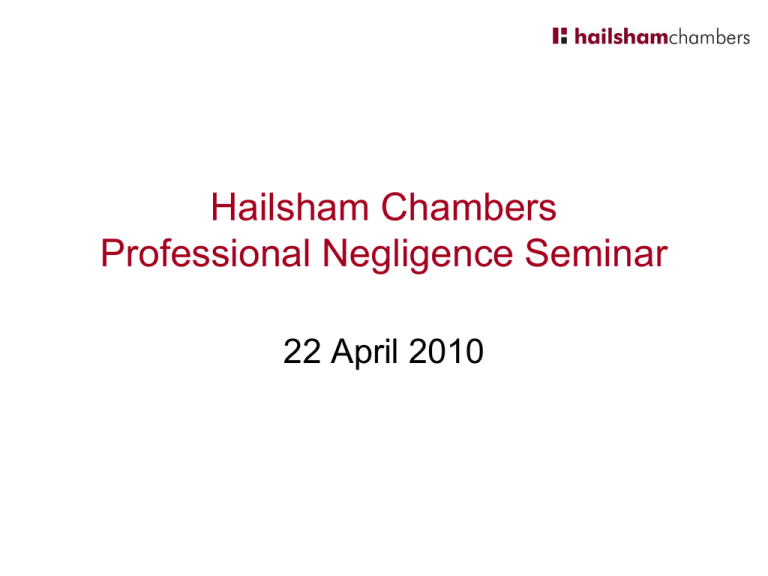
Hailsham Chambers
Professional Negligence Seminar
22 April 2010
Limitation goes to the Supreme Court
Sephton and the law of unintended
consequences
Julian Picton QC
Sephton and the law of unintended
consequences
“A contingent liability is not as such damage until the
contingency occurs. The existence of a contingent
liability may depress the value of other property, as in
Forster v. Outred & Co [1982] 1 W.L.R. 86, or it may
mean that a party to a bilateral transaction has received
less than he should have done, or is worse off than if he
had not entered into the transaction (according to which
is the appropriate measure of damages in the
circumstances). But, standing alone as in this case, the
contingency is not damage.”
Per Lord Hoffmann in Law Society v. Sephton & Co (a firm)
[2006] 2 AC 543.
The Accrualisers’ Mantra
“It is unjust and unreasonable to expect the
Plaintiff to commence proceedings before the
contingency is fulfilled. If an action is
commenced before that date, it will fail if the
events so transpire that it becomes clear that no
loss is, or will be incurred .... In such cases it is
fair and sensible to say that the Plaintiff does not
incur loss until the contingency is fulfilled.”
Per Australian High Court in Wardley Australia
Limited v. State of Western Australia (1992) 175
CLR at 533
The Limitationists’ Credo
”Within the bounds of sense and
reasonableness the policy of the law
should be to advance, rather than retard,
the accrual of a cause of action .... This is
especially so if the law provides parallel
causes of action in contract and in tort in
respect of the same conduct.”
Per Lord Nicholls in Nykredit Mortgage
Bank v. Edward Erdman Group (No. 2)
[1997] 1 WLR 1627
Forster v. Outred & Co [1982] 1 W.L.R.
86
Stephenson L.J: “I would accept Mr Stuart Smith’s statement of
the law and would conclude that on the facts of
this case the Plaintiff has suffered actual
damage for the negligence of her solicitors by
entering into the mortgage deed, the effect of
which has been to encumber her interests in the
freehold estate with this Legal Charge and
subject her to liability which may, according to
matters completely outside her control, mature
into financial loss – as indeed it did....”
• Dunn L.J: “Before she executed the mortgage deed she
owned the property free from encumbrances;
thereafter she became the owner of a property
subject to a mortgage. That, in my view, was a
quantifiable loss as from that date the cause of
action against her solicitor was complete
because at that date she had suffered damage.
The actual quantum of damages would, of
course, depend on events between that date
and the date when the damages had finally to be
assessed but the cause of action was complete
when she executed the mortgage without proof
of special damage.”
D. W. Moore v. Ferrier [1988] 1 W.L.R.
Bingham L.J: “If, in a contractual claim for negligence,
the Court would have awarded other than
nominal damages, I do not see how it can
be said that an action in tort based on the
same negligence would have been bound
to fail for want of any damage as an
essential ingredient of the cause of
action.”
Sephton’s argument
• The moment that a misappropriation occurred, the Law
Society came under a contingent liability in that it was
probable that the client who had been defrauded would
in due course make a successful claim on the Fund.
• This contingent liability fell within the formulation of
“damage” established in Forster, Moore et al.
• The Law Society’s cause of action accordingly accrued
when the misappropriations occurred and not when
claims were subsequently made on the Compensation
Fund or when the Fund paid out the claims.
Per Lord Hoffmann at paras 30 and 31: “In my opinion, therefore, the question must be
decided on principle. A contingent liability is not
as such damage until the contingency occurs.
....... No doubt in most cases in which a party
incurs a contingent liability as a result of entering
into a transaction, that liability will result in
damage for the reasons already discussed in
relation to bilateral transactions. But I would
prefer to put my decision on the simple basis
that the possibility of an obligation to pay money
in the future is not in itself damage.”
Per Lord Walker at para 48: “Your Lordships have not, I think, been shown
any case in which the imposition on a claim of a
purely personal and wholly contingent liability,
unsecured by a charge on any of the claimant’s
assets, has been treated as actual loss. That
would have been the position if the claimant in
the Forster case had given a personal covenant
guaranteeing her son’s debts (which she seems
not to have done – she paid them simply to
prevent enforcement of the security on her farm)
and if she had not given any security over any of
her own assets.”
Axa Insurance Limited v. Akther & Darby Solicitors
& Others [2009] EWCA Civ 1166
Arden L.J: • “In my judgment, the true ratio of Sephton is that there has to be
measurable loss as defined in Wardley for time to begin to run for limitation
purposes. On this basis what has to be shown is additional loss, and that
loss does not have to be of a kind previously considered in the case law.”
Longmore L.J: • “The most than can be said in the present case is that the loss suffered by
the claimant insurers is contingent upon the claim, which is (ex hypothesi)
likely to fail, actually failing. But that does not make the case a case of a
mere contingent liability because the claimants have entered into a flawed
transaction which they ought not to have entered into. To my mind that is
the damage which the claimants have suffered and that occurred at the time
of the inception of the policies.”
Lloyd L.J (dissenting): • “I have found this case far from easy to decide, not least because the
application of the decision in Sephton seems to me to produce a result
which is at odds with that which one would anticipate, in terms of the
commercial and economic reality of NIG’s position.”
Rationalising Sephton
•
•
•
•
In cases where, as a result of the negligence of the professional advisor, the claimant
is exposed to a pure contingent liability, time starts to run when the contingent liability
materialises.
Example: Law Society v. Sephton
In cases where the value of an existing asset is immediately reduced or extinguished
as a result of the negligence of the professional advisor, time starts to run from the
date on which the value is first reduced.
Examples: Forster v. Outred, Bell v. Peter Browne & Co [1990] 2 Q.B. 495, Hatton v.
Chafes [2003] P.N.L.R. 24
In cases where the claimant enters into a transaction with a third party as a result of
the negligence of his adviser which, but for that negligence, he would have entered
into on better terms, time starts to run from the date on which the claimant entered
into the transaction.
Examples: D. W. Moore & Co v. Ferrier, Knapp v. Ecclesiastical Insurance Group plc
[1998] P.N.L.R 172
In cases where, but for the professional adviser’s negligence, the claimant would not
have entered into the transaction at all, time starts to run when any benefit to the
claimant derived from the transaction is outweighed by the detriment created by the
transaction.
Examples: Nykredit, First National Commercial Bank plc v. Humberts [1995] 2 All ER
673
Conclusions
• If your objective is to accelerate the accrual of a
cause of action, then avoid Sephton at all costs.
If confronted with it, focus your efforts on
locating a loss additional to the alleged
contingent liability.
• If your objective is to survive a strike out on
limitation grounds, then invoke Sephton and
argue that the loss claimed is a pure contingent
liability.
• There is plenty in the judgments in Axa to assist
with either argument.
“This matter comes before the Court on the
Claimant’s motion … the latest in a series of
Gordian knots that the parties have been unable
to untangle without … the courts … it is ordered
that the motion is denied. Instead the Court will
fashion a new form of ADR, to wit at 4pm on
Friday, Counsel shall convene at a neutral site
agreeable to both parties … and shall engage in
one game of “rock, paper, scissors”. The winner
of this engagement shall be entitled to select the
location for the deposition …”
Avista Management v Wausau Underwriters
Solicitors’ liability for breach of
undertakings
Laurie West-Knights QC
Head of Commercial Group
Hailsham Chambers
• Sue on it, if contractual
• Use the powers of the SRA
• Use the summary jurisdiction of the
Court over its officers
An undertaking is a statement
made by you or your firm [in your
capacity as a solicitor] to
someone who reasonably relies
on it, that you or your firm will do
something or cause something to
be done, or refrain from doing
something [or cause something
not to be done]. Code of Conduct
The summary jurisdiction to
enforce undertakings is a
manifestation of the powers of
the Court over solicitors as its
officers. Now statutory: 50
SCA 1981
37. …..why on earth can you not use the negotiations to
establish the truth of the what the concluded contract
means? Not to do so would strike my mother as "barmy".
Perhaps I should simply say it strikes me as illogical.
41 There is little point in expanding upon these reasons for I
am outnumbered, nay outgunned, by the commercial
colossi seated either side of me. I prefer the instincts of
the youthful Stanley Burnton J. before he became
corrupted by the arid atmosphere of this Court. It goes to
prove what every good old-fashioned county court judge
knows: the higher you go, the less the essential oxygen of
common sense is available to you. So I am unrepentant.
With, of course, great respect to my Lords, I dissent.
The approach to construction
and interpretation of an
undertaking follows the
general approach applicable to
documents
Where there is ambiguity in an
undertaking, it will generally be
construed against the solicitor
who gave it
If the undertaking is not
performed, the recipient can apply
to the Court for an order enforcing
it. On that application the Court
can exercise its discretion, if it
thinks fit, to require the solicitor to
perform the undertaking.
Thereafter, the appropriate step,
in default of compliance, is an
application to commit
Because the application is made
under the inherent jurisdiction of the
Court empowering it to control its
officers by making orders enforceable
against them personally, common law
questions of consideration, statutory
formalities and limitation, do not arise.
Delay can justify a refusal to grant
relief if it renders the making of an
order unfair and unjust
There is no absolute right on the part
of the recipient of an undertaking to
have it enforced. The Court must be
satisfied that the relief being sought
can properly be granted in the
exercise of its discretion, a question
which raises similar questions to
those that arise on an application for
relief by way of an order for specific
performance
No Court will make any order against
a party when the step in question is
impossible to carry out, but
impossibility has a clear meaning,
which goes beyond difficult,
embarrassing or expensive. It applies
where the act in question can
properly be said to be impossible and,
in such a case, compensation can be
ordered in place of specific
compliance
As with a claim for equitable relief against
a person, the Court can be asked to take
into account, on an application for
enforcement of an undertaking the fact
that undue hardship would be caused by
the making of the order in question, but
facts sufficient to support such a step have
to be sufficiently extreme that they justify
the conclusion that the order sought would
be unfair, unconscionable and unjust
A variety of arguments have been
deployed by defendants seeking to
avoid the consequences of giving
undertakings and failing to perform
them, but the importance of
undertakings means that the Court
will be reluctant to allow a solicitor to
escape from their consequences save
in the most exceptional of cases
Relevant Authorities
•
In re Grey
[1892] 2 Q.B., 440
•
Re a solicitor
[1966] 1 WLR., 1604
•
L Morgan and Co-v-Jenkins O’Dowd and Barth
[2008] EWHC Ch., 3411 and 3574;
Blackburne.J. October 2nd 2008; Henderson.J.
November 19th 2008
•
Investors Compensation Scheme-v-West Bromwich
Building Society
[1998] 1 WLR., 896
•
Hall-v-Vernon
(1899) 34 S.E., 764 (Supreme Court of Appeals of
the State of West Virginia)
•
Pasedina Holdings pty ltd-v-Khouri
(1977) 1 BPR., 9460 (Supreme Court of New South
Wales)
•
Udall-v-Capri Lighting
[1988] Q.B., 907
•
John Fox-v-Bannister King and Rigbeys
[1988] Q.B., 925
•
Taylor-v-Ribby Hall Leisure Ltd
[1998] 1 WLR., 400
•
Citadel Management-v-Thompson
[1999] 1 FLR., 21
•
“Tis Folly”; Ryan Clement
[2009] Sol Jo 153 (7) 14; May 5th 2009
Reddy-v-Lachlan
[2000] Lloyds PN 858
•
“A recipe for litigation?”; Malcolm Dowden and
Elinor Clark
159 NLJ., 418; March 20th 2009
•
“Dangerous Sports; Solicitors Undertakings in
Conveyancing Transactions”
Adrian Pay and Shelley White; PNBA Law Review
May 2009
•
•
•
Hole and Pugsley-v-Sumption
[2002] Lloyds PN 419
Angel Solicitors-v-Jenkins O’Dowd and Barth
[2009] EWHC Ch., 46; [2009] 1 WLR., 1220
Summary
• Look at Solicitors’ Negligence and
Liability, Flenley [QC] and Leech for
more
• Take great care not to make promises
qua solicitor; it could cost you more than
an insurance claim.
Solicitors’ liability for breach of
undertakings
Laurie West-Knights QC
Head of Commercial Group
Hailsham Chambers
Lenders’ claims and breach of
warranty of authority
Joshua Munro
Why is this form of liability so popular?
• Not fault-based.
• No parallel liability in negligence so
contributory negligence not relevant:
Vesta v Butcher [1989] AC 852.
• Impostors are thick on the ground.
Origins
• Law of agency.
• A sustains loss as a result of an intermediary, B,
claiming to be the agent of C with authority to act on C’s
behalf.
• Paradigm case: principal A enters into a contract via B
where he is under the impression as a result of what B
has said or done that B is the agent of C and can bind C.
If C is entitled to repudiate the contract because of B’s
lack of authority A can sue B for a breach of B’s warranty
of authority provided A relied on the warranty to his
detriment.
• Measure of loss is the usual contractual measure. A is
entitled to be put in the position in which he would have
been if the warranty had been true and if the contract
had bound C.
Nota Bene:
1. doctrine designed to apply in a contractual situation;
2. must have been a representation by a putative agent he is
authorised to act for a principal;
3. such a representation may be express or implied;
4. the warranty must have been relied upon ie counter-party must
have been induced to contract on the faith of the warranty;
5. irrelevant whether the agent vouching his authority has exercised
reasonable care;
6. irrelevant whether the person relying on the warranty has exercised
reasonable care;
7. the measure of loss is designed to afford compensation sufficient to
place A in the position he would have been in had he had the
counter-party which he supposed he had.
Implied contract reasoning is well
entrenched
Collen v Wright (1857) 8E&B647:
“The obligation arising in such a case is well expressed by saying
that a person professing to contract as agent for another, impliedly if
not expressly, undertakes or promises the persons who enter into
such contract, upon the faith of the professed agent being duly
authorised, that the authority which he professes to have does in
point of fact exist”
CA in OBG v Allan [2005] QB 762 at [87]:
“An innocent third party, with whom the agent has purported without
authority to make a contract or to reach a settlement of outstanding
liabilities under a contract, will be able to hold the agent liable for
breach of the warranty of authority which the law decided long ago
should be implied to give a remedy in such a situation (see Collen v
Wright (1857) 8 E&B 647). Liability for breach of warranty of
authority is strict. It does not depend on whether the agent has
been negligent or not...”
The measure of loss
• Habton Farms v Nimmo [2004] QB1, CA
approving McGregor on Damages, viz:
“1311. Given an enforceable contract had the
agent had authority and given a solvent
principal, the damages will be based on the
measure of damages that the plaintiff could have
recovered in an action for breach of contract
against the principal had the principal been
bound, and this will generally give him damages
for the loss of his bargain”
Development beyond the contractual
model
• Eg in litigation: Yonge v Toynbee [1910] 1 KB 215. Strict liability if
client does not exist, dies, is struck off, or goes mad.
• But there are limits...
• CA in SEB Trygg Liv Holding Aktiebolag v Manches and Others
[2006] 1 WLR 2276 - a solicitor warrants he has a client who exists
and has given authority to commence proceedings but does not
warrant he has correctly named his client. Does not warrant the
accuracy of his instructions or that the client has title to sue or that
he is solvent either.
• Uncertainty over the correct measure of loss: Fernee v Gorlitz [1915]
1 Ch 177 cf Skylight Maritime SA v Ascot Underwriting Ltd [2005]
PNLR 450 at para [16].
Property claims: an orthodox case
• Solicitor can be liable to a counter-party for breach of warranty if not
authorised to contract on behalf of the client (whether acting for
purchaser or vendor).
• Solicitors do not ordinarily have ostensible authority to enter
property contracts: James v Evans [2000] 3 EGLR 1 at 5C-E.
• Contractual measure will apply ie what might have been recoverable
from the supposed principal if he had failed to complete: Suleman v
Shahsavari [1988] 1 WLR 1181.
• If the supposed principal would have been insolvent or would have
had a defence that can be prayed in aid by the agent: Singh v
Sardar Investments Ltd [2002] All ER (D) 243.
Property claims: Penn v Bristol & West
Penn v Bristol & West Building Society [1997] 1 WLR 1356: solicitor for
H and, supposedly, W on sale of home. Fraud by H. W’s signature
forged: sets aside contract and transfer.
• No liability of solicitor to purchaser because purchaser in league
with husband.
• Can the solicitor be liable to the purchaser’s lender even though the
solicitor’s principals were not purporting to contract with that lender?
• CA say yes as warranty of authority given to lender via its own
solicitors; lender had relied on it and had given consideration for it
by entering into a collateral contract of loan to the purchaser
necessary to bring the transaction to fruition.
An alarming result as (1) solicitors liable to a party which did not purport
to contract with their principal; (2) the warranty was inferred from the
mere fact of the solicitor holding himself out as authorised to act for
the supposed clients in correspondence.
Property claims: Penn: après moi le
deluge?
As a result of Penn:
• solicitors potentially liable for breach of warranty of authority not only
to the principal on the other side of the transaction but also to a
lender lending money to that principal;
• taken at face value it means liability extends to all persons the
solicitor knew or should have known might foreseeably rely on the
warranty and to whom it can plausibly be said the warranty was
given.
CA also state that the measure of loss was not what could have been
recovered from the wife if the warranty had been true, and on the
supposition she wished to proceed; the lender could recover all
losses flowing from having advanced money on the strength of the
warranty.
Property claims: Bristol & West Building Society v Fancy &
Jackson [1997] 4 All ER 582 at pp612-3; Cooke v Borsay
Re-mortgage: solicitors acted both for the lender and,
apparently, for W who had not authorised the solicitors at
all. Another fraud. Another worrying development.
• Chadwick J:
• Solicitors not liable to the lender under their contract of
retainer because terms did not impose strict liability.
• No reason why the solicitor could not be liable for breach
of warranty of authority insofar as purporting to act as
agent for the borrower. Penn applied.
Property claims post- Penn and Bristol & West
The position reached:
1. a solicitor purportedly acting for one party to a property transaction
may be liable to the counter-party if it turns out he does not have
authority to represent his client (or enter a contract on his behalf)
and if the counter-party sustains loss in reliance on the warranty;
2. the solicitor can be liable in that way whichever side of the
transaction he is on eg whether for vendor or purchaser;
3. the transaction can also be a loan contract eg a solicitor purportedly
acting for a borrower can be liable to the lender even if the solicitor
was also contracted to the lender and is not liable under that retainer
to the lender;
4. the solicitor can also be liable to a party who was is a counter-party
to the transaction but who is merely lending money to a counterparty (typically the purchaser).
Property claims: is this progress?
• why should this inflexible form of quasi-contractual
liability apply where A was not looking to enter a bargain
with C at all?
• why should it apply where contractual relations exist
between A and B and where that contract is inconsistent
with the implied warranty of authority?
• is the doctrine suited for the kind of multi-factorial
situations which arise in property transactions
nowadays?
• does its development in this field support or subvert
fundamental contractual principles?
Property claims: a case for the defence
Midland Bank v Cox McQueen [1999] Lloyd’s Rep PN 223.
Solicitors instructed by the bank on the recommendation of H to
explain loan documentation to W. H passes off an imposter as W
and W is not bound by the documentation. Solicitors sued in
negligence and for breach of warranty based on a certificate by the
solicitor that the documents had been explained to W and she
understood them fully and had signed voluntarily.
• CA adopt the same approach to the construction of the solicitors’
ordinary obligations as to the certificate containing the warranty of
authority.
• Held: the bank had not intended to ask for and the solicitors had not
intended to give a guarantee against fraud which could not be
detected with reasonable care.
Property claims: current issues
Two questions.
• Does the solicitor warrant that he has a client who goes
by the name of X or does he vouch for the identify of the
client ie “I warrant that I act for (the real) X”?
• How is all this affected by the CML standard terms? Is a
solicitor retained pursuant to those terms going to be
liable for breach of warranty of authority to his lender
client or to a party on the other side of the transaction?
• Would Bristol & West and Penn be decided the same
way in a CML case?
Excel Securities PLC v Masood and Others
• Lender’s claim for summary judgment v. solicitors - arising out of
identity theft.
• Not a CML case. Solicitors acting for borrower not lender. Lender
has own solicitors.
• Imposter adopts identity of a real individual named James Goulding
to extract moneys from Excel by deception. James Goulding said to
be resident at 108 Midland Road, Luton sought a loan of £910,000
to acquire additional properties offering as security a property
registered in his name at 17 Richards Place, Chelsea, London SW3
2LA.
• Lender conducts its own identity checks.
• Fraud uncovered after loan made with large losses incurred.
• Solicitors alleged to be in breach of warranty having warranted they
acted for Mr Goulding the owner of 17 Richards Place when they
had no such client.
Excel Securities PLC v Masood and Others (cont’d)
HHJ Hegarty QC:
•
•
•
•
•
•
•
in a context like that in Penn or Bristol & West there could be no doubt as to the
identity of the person for whom the solicitor was purporting to act, namely the wife of
the person instructing him, and in such a case there would be a warranty the client
was that person.
it did not follow that in every case an agent must be regarded as warranting the
identity of his client and not merely the fact that he has authority to act on the client’s
behalf.
the fundamental reason for the warranty was to ensure A was protected against the
risk that B did not have the authority which he claimed but an agent would not
normally be deemed to warrant any particular attributes of the principal or other
aspects of the transaction in which the agent claimed to be acting on a principal’s
behalf.
the obligations undertaken by a professional are usually limited to the exercise of
reasonable care so special facts or clear language required to impose a stricter
obligation.
necessary to have regard to the specific circumstances which arise in any particular
case in order to determine the extent of the warranty given.
an objective question to be determined by reference to the circumstances prevailing
and known to the parties at the time when the warranty was deemed to have arisen.
considerations like those in Midland Bank Plc v Cox McQueen may be relevant.
Excel Securities PLC v Masood and Others
(cont’d)
•
•
•
•
•
•
•
Excel a commercial lender which had undertaken its own checks to guard against
identity theft and had decided to lend at a time when it was aware of the risks of
identity theft.
The solicitors would ordinarily be expected to exercise reasonable skill and care only
and they had carried out their own identity checks which had led them, like Excel, to
accept that their client was the person he represented himself to be.
No express warranty or undertaking sought by Excel.
Not reasonable to hold solicitors had impliedly warranted the identity of their client or
his title to the property in question. All they had done was to warrant they had
authority to act on behalf of a client who identified himself as Mr Goulding and
claimed to be the registered proprietor.
Penn etc distinguishable because there could have been no real question as to the
identity of the person on whose behalf the solicitor was claiming to be acting, namely
W.
“For my part, I can see no justification why risks of this kind should be transferred
from the shoulders of a commercial concern such as Excel on to those of a
professional firm such as BM Solicitors”
Case now off to CA after the judge gave summary judgment for the solicitors.
Excel Securities PLC v Masood and Others: the postmortem
• Professor Francis Reynolds addresses the PNBA.
• In the context of a contract relating to the disposition of land
(including the charging of the land) the solicitor should be taken to
warrant that he acted for the named person on the assumption that
he was the owner of the land.
• To hold that the warranty was only that the solicitor had authority to
act for a person going by the name of Mr X who claimed to be the
same individual as the person who appeared to be the registered
owner took the whole force of the warranty away.
• General considerations of the kind dealt with in Midland Bank v Cox
McQueen ought not to count.
• The same approach should follow if there is a co-existing retainer
between the agent and the lender based on negligence liability.
Chadwick J. in Bristol & West got that right.
Impact of the CML Terms
• Solicitor acts for borrower and lender and CML terms apply in latter
retainer.
• CML Handbook specifies the identity checks which such a solicitor
is obliged to undertake and requires the solicitor to file a certificate
of title in the form approved by the Solicitors’ Code of Conduct 2007.
• By that certificate the solicitors certify they have checked the identity
of the borrower and anyone else required to sign the mortgage deed
by reference to the documents stipulated.
• Certificate cites that the solicitors’ duties are limited to the matters
set out in the certificate and they accept no further liability or
responsibility whatsoever.
• The Code prevents a solicitor going any further than “taking
reasonable steps to check the identity of the borrower (and anyone
else required to sign the mortgage deed or other document
connected with the mortgage)”.
• Money Laundering Regulations too...
Impact of the CML Terms (cont’d)
•
Can a solicitor be liable for breach of warranty of authority to a lender where his own
contract with that lender is limited in these ways?
•
For Professor Reynolds and Chadwick J. the terms of a solicitor’s contract with the
lender are conceptually distinct from the warranty given when bringing together a
contract between lender and borrower.
•
Surely scope for a contrary view: reasoning of the kind deployed in Midland Bank v
Cox McQueen as a means of curtailing any liability of a collateral kind referable to the
solicitor’s role as agent for the borrower.
•
An instance of particular contractual terms defining precisely what risks the solicitor is
prepared to accept and thereby modifying the warranty?
•
HHJ Behrens in Halifax Plc v Brookes Parry (2000) (unreported) accepted this
(although not a CML case).
•
On this basis, Cooke v Borsay might be distinguishable in a case where the solicitor
acts for a lender pursuant to the CML terms while also acting for a borrower who is
purchasing or re-mortgaging.
Impact of the CML Terms (cont’d)
• What about Penn?
• The argument is less strong when the solicitor has no contractual
relationship with the lender asserting a breach of warranty of
authority, as in Penn.
• Arguable that the standard terms of modern conveyancing and the
imposition of universal statutory and regulatory obligations such as
with regards to money-laundering means that solicitors are
understood to warrant no more than that they have undertaken
appropriate checks as per the applicable regulatory and statutory
obligations to establish they are duly authorised by a client having
an identity as claimed?
• Professor Reynolds thought Penn was wrongly decided, but not for
this reason.
Self-protection
What can solicitors do to protect themselves?
• Not a lot unless the law changes - although
always sensible to be extremely careful about
checking for whom they act.
• Theoretical possibility of issuing notice that not
guaranteeing that the client is who he says he is.
That would modify the warranty: Suleman v
Shahsavari [1988] 1 WLR 118 at 1184G-1185D.
• Doubtful whether this would be at all sensible in
practice.
What questions should you pose when facing a breach of warranty claim?
•
Was the warranty given to / can it be relied upon by the person seeking to invoke it – this may turn not just on the
wording and the context but also on whether the solicitor knew or should have known that person would be
induced to act in reliance upon it;
•
What precisely was warranted – it may be arguable the warranty should be differently construed or that it was
excluded or modified in some way, perhaps reducing it to an obligation to make specified checks, or to use
reasonable care;
•
Was the solicitor retained by the person seeking to invoke the warranty - if so, it could be argued that the terms of
the retainer are inconsistent with the terms of the warranty such that no warranty or only a modified warranty
should be implied;
•
Was the identity of the client of crucial importance – if not - eg the borrower seeking to raise finance to buy further
properties as in Excel - then, subject to the fate of Excel, you can argue that the warranty does not extend to the
identity of the client but is limited to a promise that the solicitor acts for a client who claims to have that identity
and/or to be the owner of a particular property or properties;
•
Be wary of claimants seeking to rely upon and even extend Penn so as to allow third parties who were not the
principal contracting party to invoke the doctrine: short of the Supreme Court Penn is unlikely to be overturned but
it is open to argument whether Penn should be extended any further;
•
Remember that it is always necessary for a lender to prove reliance, which is not straightforward - whether it can
be proved may turn on precisely what was warranted;
•
Are you feeling very adventurous - if so, you might argue that developments in the regulatory and legislative
spheres and standardised conveyancing obligations all mean that it is no longer appropriate to regard solicitors as
warranting anything more than they have a client whose identity they have checked as stipulated by the applicable
standard terms, statutory rules and professional regulations.
Disclosure Issues and Quinn v Law
Society
Eva Ferguson
Topics
• Quinn v The Law Society (Peter Smith J,
[2009] EWHC 2588 (Ch)). Now on appeal
to CA
• Pre-action disclosure: CPR Part 31.16
Quinn Insurance v The Law Society
ISSUES FOR INSURERS
1. Access to documents following
intervention?
2. Inspection of privileged/confidential
documents prior to a claim being made?
Facts
• C insured 2 partner firm
• October 2007 Intervention
• Numerous claims made by lenders
concerning transactions in which Mr O had
acted. Many more in the pipeline
• Small firm but large sums
• Mr O was refused indemnity – dishonesty
• Mr I – rights reserved - no dishonesty
alleged at time
C’s Part 8 Application
• Required: “access to all such documents of
[the Firm] as the D has in its possession or
control including without limitation all
accounting records to consider whether
under the policy the C is obliged to indemnify
or obliged not to indemnify Mr I”
• The Problem: this included documents which
were
- from files not relevant to any existing claims
- privileged/confidential
The Micawber factual premise
C’s premise: “extraordinary that, when a small firm has
been subject to such investigation one of the two
partners should have succeeded in plundering millions
of pounds from lenders through abuse of the client
account without the other partner … having been
aware of (and therefore condoning) what was going
on.”
Rejected:
- The belief that ‘something will turn up’ is insufficient
- “it is predicated by a false assumption of dishonesty of
every partner in a small firm”
Law Society stance
“The Society is a public body subject to public law duties. These govern
its decision whether to allow access to documents and if so on what
terms. The Society is legal custodian of the documents and with
responsibility to deliver them to the solicitor’s former clients or to
their order and in the meanwhile to preserve client confidentiality
and the integrity of the files. Its primary concern must be to protect
the interests of the solicitor’s former clients. The solicitor may have a
legitimate interest in obtaining access to the files as a necessary
preliminary stage before taking action to protect and enforce his
right of recovery of sums due to him. The Society should have
regard to that interest and balance that interest against the
perceived interests of the former client” per Lightman J in Dooley v
The Law Society (The Times 16.1.2002)
So: refused blanket request; provided documents where claims already
made and thus privilege not an issue
Quinn’s Primary Argument
• Quinn, as primary insurer, entitled to a role
in the regulatory procedure akin to that of
the Law Society
• Rejected
– Not intended by the statutory regime
– Purpose of application not in public interest
unlike regulatory role of Law Society
– Rights as Insurer of a solicitor cannot override
Insured’s client’s rights of confidence and
privilege
Quinn’s Secondary Argument
Rights under the Insurance Policy
“6.2 Notice and Claims Procedure
In the event of any occurrence which may give rise to
liability under this Policy, and regardless of the
likelihood or probability of a claim being brought under
this policy: a) the Insured shall: (1) Notify the [insurer]
immediately you become aware of any incident or as
soon as practicably possible … and as soon as
possible thereafter, provide any other documentation
that the [insurer] may require with regard to the
occurrence. ..(4) Give all such information and
assistance as [the insurer] may require”
Rejected:
• Law Society not party to the Insurance
Contract
• Solicitor’s own working papers no longer
its own [para 12 Sched 2 Solicitors Act
1974]
• Access to these depend on application of
Dooley
– Duty to balance interests of solicitor (or
insurer) vs former client and to preserve
confidentiality
• No grounds for requiring the Law
Society to provide access
– Had already provided documents where
privilege waived
– Request not specific enough
– No fraud exception
– Privilege of the client remains paramount
• As a matter of construction could not rely
on clause 6.2(4)(a) – conflict
• CPR 31.17?
– No claim against Mr I
– Privilege of clients would still be an obstacle
The Problem for Insurers Pre-Claim
• Can Insurers review sample files to ascertain
the extent of a suspected wide-spread fraud?
• Can Insurers review privileged material when
circumstances notified?
• Policy term alone cannot override
confidentiality/privilege
• ‘Claims made insurance’ an exception to
confidentiality?
• Quinn gives no support to this argument
Summary
• Where claim made against Insured, Insurer can
access documents whether or not there has been
intervention
• Where claim not made, access to Insured’s own
documents following intervention will depend on
Dooley
• Where claim not made, and exceptions do not
apply, very difficult to access Insured’s client’s
documents which are confidential and privileged,
whether or not there has been intervention
CPR Part 31.16
CPR 31.16
Disclosure before proceedings start
(1)This rule applies where an application is
made to the court under any Act for
disclosure before proceedings have
started
(2)The application must be supported by
evidence
CPR Part 31.16
(1) The court may make an order under this rule only
where –
(a) The respondent is likely to be a party to subsequent
proceedings.
(b) The applicant is also likely to be a party to those
proceedings.
(c) If proceedings had started the respondent’s duty by
way of standard disclosure would extend to the
documents or classes of documents of which the
applicant seeks disclosure…
(d) … disclosure is desirable to dispose fairly of the
anticipated proceedings … assist the dispute to be
resolved without proceedings … save costs.
CPR Part 31.16
Black v Sumitomo (CA, [2002] 1 WLR 1562)
- Discretion is not confined. Judicial gloss of
Rix LJ.
- “likely to be a party” does not mean on the
balance of probabilities a claim will ensue
- “may well be a party” if proceedings
ensue.
CPR Part 31.16
• Then:
– Jurisdictional threshold (which is low – real
prospect that it satisfies one of the
conditions). Need to show real prospects of
success.
– Discretionary decision: nature of loss
complained of; identification of the issues
raised by the complainant etc
CPR Part 31.16
• Professional Negligence Pre-action protocol
- To a degree, mirrors pre-action disclosure
- “The parties should supply promptly at this
stage and throughout whatever relevant
information or documentation is reasonably
requested” (B4.3)
- “No party is obliged under paragraph B4.3 to
disclose any document which a court could
not order them to disclose in the pre-action
period” (C5.1)





